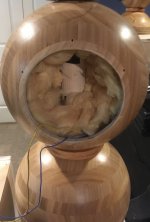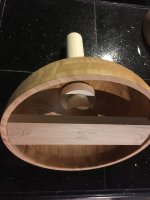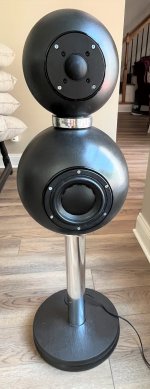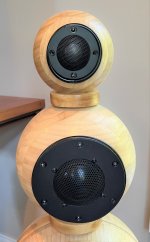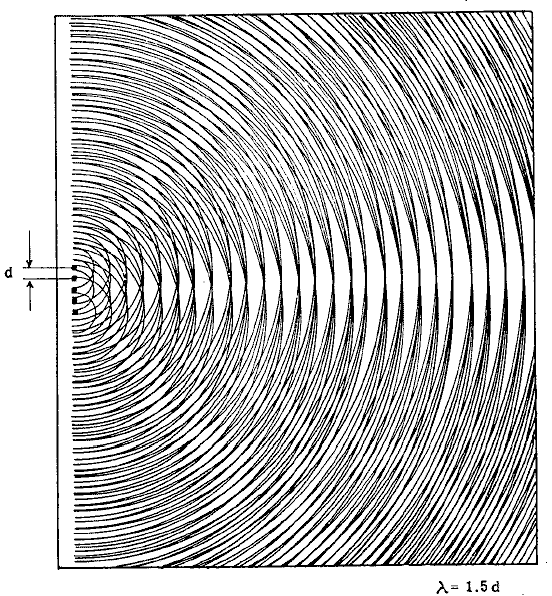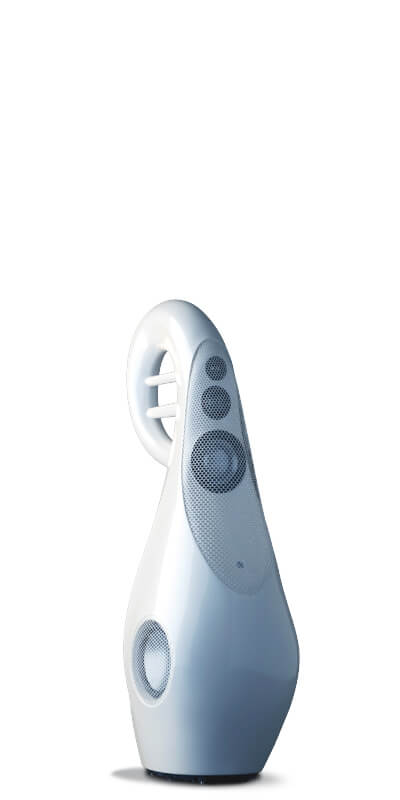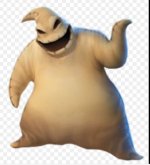As Planet 10 stated many posts ago - with a spherical enclosure one substitutes minimal diffraction on the outside for a mess on the inside unless you make it large enough to allow baffling to cut down on the standing waves generated by the constant diameter of the enclosure.
The Bell Labs folks discovered this at the beginning of audio time.
The only reason for a sphere is novelty.
The Bell Labs folks discovered this at the beginning of audio time.
The only reason for a sphere is novelty.
I have a baffle pole in mine plus 3 part damping so no resonance and spheres are strongest shape but that said dealing with one driver in a sphere is much easier
I spent many months looking for a very low distortion, non resonant, nearly full range driver. The Aurasound when mounted to a proper enclosure to carefully damp the back wave with minimal reflection filled the bill. I was really going for the pulsing sphere but stopped at 20 drivers covering the front segment for this build. Routing all those hoses off the back of the drivers became a challenge. Why not 2" or 3" drivers? I think the Aurasound 2" driver would work well. It has more limited high end, but folks over 45 years old wouldn't notice. How's the bass, non-existent really. The distortion starts to rise beginning around 700 Hz. So I crossed these over to 8" drivers at that frequency. The picture shows the poorly designed woofer cabinets I was using. I have since found the best results come from woofers mounted in the smallest possible sealed half cube shaped enclosures to damp the back wave of those drivers. I don't have anything that goes with the spheres currently. As you can see the distortion (lower traces) is down about 55 dB (10 dB per division scale) below the fundamental and the response is really pretty flat. I didn't apply the mic calibration to this measurement, so some of the upper end frequency response deviation is actually the microphone. The effect of an omni directional or wide dispersion speaker is to locate the sound right at the speaker or somewhere on a line between the speakers in a stereo pair. Sort of bringing the performance directly into the room rather than a window into the performance that narrow dispersion speakers provide. Listening to the dual mono recordings of the Beatles early stuff makes it sound like Paul is sitting playing right where the speaker is sitting in the room.This is pretty amazing
so I might be the only 4-sphere diy guy but this has to be the most drivers ever 🙂
Question how is base ? Or needs a sub
And why not less holes and say 2 in or 3 in drivers ?
Dana
Last edited:
I strongly disagree.As Planet 10 stated many posts ago - with a spherical enclosure one substitutes minimal diffraction on the outside for a mess on the inside unless you make it large enough to allow baffling to cut down on the standing waves generated by the constant diameter of the enclosure.
The Bell Labs folks discovered this at the beginning of audio time.
The only reason for a sphere is novelty.
I have made many sphere based enclosures, it is child's play to put an internal brace/braces which essentially creates two hemispheres or more subdivisions each with constantly variable diameter (no flat surfaces).
Also stuffing well with glass fibre or similar really does absorb a huge amount of any internal mess if you can't place internal subdivisions.
Failing that, if you have no stuffing to hand, no wood to make a brace, then simply ensure the constant diameter is outside the passband of the driver - just like sensible subwoofer construction.
The 'internal mess' you talk about is not a problem with sensible engineering, and the diffraction implications are on my measurements, much more than a novelty.
This is definitely innovative and that's what I personally enjoy seeing - putting 2 or 3 "normal" drivers in a box (whether bigger or smaller) has been done about 10,000 times over the years, whereas this might well be the first of its kind. The FR curve is nice down to about 500 Hz, even pretty good to 400, so while higher than a sub's top end, a couple nice woofers would do the trick. The soundstage being more enveloping is definitely a plus.I spent many months looking for a very low distortion, non resonant, nearly full range driver. The Aurasound when mounted to a proper enclosure to carefully damp the back wave with minimal reflection filled the bill. I was really going for the pulsing sphere but stopped at 20 drivers covering the front segment for this build. Routing all those hoses off the back of the drivers became a challenge. Why not 2" or 3" drivers? I think the Aurasound 2" driver would work well. It has more limited high end, but folks over 45 years old wouldn't notice. How's the bass, non-existent really. The distortion starts to rise beginning around 700 Hz. So I crossed these over to 8" drivers at that frequency. The picture shows the poorly designed woofer cabinets I was using. I have since found the best results come from woofers mounted in the smallest possible sealed half cube shaped enclosures to damp the back wave of those drivers. I don't have anything that goes with the spheres currently. As you can see the distortion (lower traces) is down about 55 dB (10 dB per division scale) below the fundamental and the response is really pretty flat. I didn't apply the mic calibration to this measurement, so some of the upper end frequency response deviation is actually the microphone. The effect of an omni directional or wide dispersion speaker is to locate the sound right at the speaker or somewhere on a line between the speakers in a stereo pair. Sort of bringing the performance directly into the room rather than a window into the performance that narrow dispersion speakers provide. Listening to the dual mono recordings of the Beatles early stuff makes it sound like Paul is sitting playing right where the speaker is sitting in the room.
Dana
View attachment 1074893View attachment 1074894View attachment 1074895
Can you post a couple pics of these spheres you built? Always cool to see other's stuff. I attached 3 pics, A) one that shows two damping approaches to tame any resonance - 1) use of thick latex paint with some cement powder mixed in to make it like cement board, and 2) gluing in rug underlay on that. Then fiberglass was also used before drivers installed (pic B). I don't like any bass reflex stuff, just the sound that comes out the front. Then the other pic C shows the bottom subwoofer sphere under construction, where the sub is down firing (I like shaking the floor a bit for the psycho acoustics even though some don't like stray waves bouncing out - but sub is low bass), and used a cross brace that also holds the center pole onto which other spheres were mounted (woofer, mid and tweeter). I did get a feature on the Ikea Hack website, even though they don't look for audio purity rather design and construction. These do get high WAF and she likes the Ikea wood finish.I strongly disagree.
I have made many sphere based enclosures, it is child's play to put an internal brace/braces which essentially creates two hemispheres or more subdivisions each with constantly variable diameter (no flat surfaces).
Also stuffing well with glass fibre or similar really does absorb a huge amount of any internal mess if you can't place internal subdivisions.
Failing that, if you have no stuffing to hand, no wood to make a brace, then simply ensure the constant diameter is outside the passband of the driver - just like sensible subwoofer construction.
The 'internal mess' you talk about is not a problem with sensible engineering, and the diffraction implications are on my measurements, much more than a novelty.
The second pair I built since are simpler, with two spheres painted black and 5-1/2" mid-woofer and 1-1/8" tweeter plus accompany 8" sub front firing. Crossed to sub at 100Hz, 12db slopes. Pic D. Sorry this pic is a bit distorted.
Attachments
The standing waves being concentrated or aligned to one frequency group (harmonics?) due to a constant diameter of the enclosure can be a large benefit if you plan for it. To have them totally aligned you would mount a driver on a flat panel with a half sphere enclosure mounted on the back. This way the path length from the rear of the driver to the spherical enclosure is equal in all directions. Watch closely. For a given desired volume the sphere will produce the shortest path length for that reflection as opposed to using the typical monkey coffin with the driver offset and magical "golden" ratios for the different lengths of the sides. The half sphere will have a first resonant frequency that is much higher than the lowest internal mode of the monkey coffin. As the effectiveness of damping material improves with increasing frequency it is much more likely that the lowest mode of the half sphere can be absorbed below audibility by sufficiently dense stuffing, where as the lowest mode of the monkey, maybe 1/3 the frequency, can't be sufficiently damped and that coffin will produce that box sound that we are all too familiar with. Most people enhance the problem by restricting the damping to an inch thick pad on just a wall or two. You may not have noticed that mounting a driver on a spherical shell does not produce the same path length for reflections in all directions from the back of the driver. So what is the problem? In fact the driver is not mounted at the focal point for the wall behind the driver, it is not in a position to effectively pump energy into the uniform length mode of the sphere. That would require venting the back of the driver at the center of the sphere so that the energy would then have an equal path length to the shell in all directions. Until you accurately model or build and test these configurations it is easy to hold strong to these cautionary tales repeated around camp fires across the land. It wasn't until I built and tested my first cube shaped box that I realized the error made by the box software I was using when computing box modes. I intentionally built the cube to align all the modes. It didn't work. Of course when I built a half cube and mounted the driver centered on the square side, all the modes aligned as I had desired and the damping was able to make them inaudible. I found that the hornresp software models these cabinet internal modes correctly. I haven't seen the measurement from the Bell Labs that are referenced. Perhaps the folks that quote them could produce them here to support their hypothesis.As Planet 10 stated many posts ago - with a spherical enclosure one substitutes minimal diffraction on the outside for a mess on the inside unless you make it large enough to allow baffling to cut down on the standing waves generated by the constant diameter of the enclosure.
The Bell Labs folks discovered this at the beginning of audio time.
The only reason for a sphere is novelty.
Last edited:
Sure!
There are many more. Some documented here, some not. These are a couple of my larger builds. One four way with high end drivers. One a two way synergy horn build.
Just search up my threads.
I am currently running minimal baffle 5 way open baffle speakers....
Yet to build a line array or a really nice horn system, but they are on the to do list.
Wow love the first example. That's a 3-sphere Ikea with a very cool base. Is there a pole inside joining the two larger spheres? Are the backs painted or stainless? The driver in the center looks interesting, what type? The tweeter has a larger faceplate but so does the 1 1/8" Dayton I used for my second build, whereas I used what is technically a car tweeter on the first and that has a reduced the plate area. Then again the 2" dome Dayton mid has a large plate also.View attachment 1075635
View attachment 1075636
View attachment 1075637
View attachment 1075638
Sure!
There are many more. Some documented here, some not. These are a couple of my larger builds. One four way with high end drivers. One a two way synergy horn build.
Just search up my threads.
I am currently running minimal baffle 5 way open baffle speakers....
Yet to build a line array or a really nice horn system, but they are on the to do list.
Your other ones are huge!
Attachments
Looks like that nearly 20 pound Volt midrange. You don't want to drop one of those on your foot. After getting a pair I decided I was too old and weak to put drivers that heavy in my builds. Those things are very pretty. If anyone decides to buy these drivers, ask for extra packing. Mine were double boxed, and had managed to destroy the inner box and had started to tear a whole in the outbox. They are beasts and they want to come out and play.View attachment 1075635
View attachment 1075636
View attachment 1075637
View attachment 1075638
Sure!
There are many more. Some documented here, some not. These are a couple of my larger builds. One four way with high end drivers. One a two way synergy horn build.
Just search up my threads.
I am currently running minimal baffle 5 way open baffle speakers....
Yet to build a line array or a really nice horn system, but they are on the to do list.
I think there are OSHA regulations on using 20lb drivers so you don't suffer from back injuries (ok jk 🙂Looks like that nearly 20 pound Volt midrange. You don't want to drop one of those on your foot. After getting a pair I decided I was too old and weak to put drivers that heavy in my builds. Those things are very pretty. If anyone decides to buy these drivers, ask for extra packing. Mine were double boxed, and had managed to destroy the inner box and had started to tear a whole in the outbox. They are beasts and they want to come out and play.
Hence the perfect rectangle ductwork in 3 fold or 2 fold if not offset entry at (0.349)quarterwave pipes potentially promoting this and not a bunch of extra stuff that you would find in tapers or flares or 45° folds/turns/deflectors, etc. subwoofer might prevail if arguing this as its easier to employ. Full range may default to tApered and stuffd regardlessA pulsating sphere that would radiate sound equally in all directions sounds nice in theory. And it would in a non reflective environment, but those are hard to find.
For a reflective environment, you want straight FR on axis, but a down sloping power response. Logic dictates that this cannot be achieved with a pulsating sphere.
A reflective environment is a primary reason for building omni directional speakers. I suppose if you invited someone to come play a cello in your room, you would place them in a box only open at the front that was stuffed with sound absorbing foam, to block and absorb the side, top and back waves, so only the forward directed sound would reach you. That would be nuts. All those reflections from the omnidirectional source lets you locate the source in the room. The omni pattern lets you have the performance in your room such that the room acoustics dominate. So recordings without ambience are perfect for playback on omni systems. Nice cardioid pattern, forward firing speakers and rooms with walls covered in heavy sound absorption drapes, like a home theater or recording studio monitoring room, reproduce a window into the recorded space, where the recorded ambience dominates and your room is made to not interfere. Go read the white paper published about the Beolab 90 speaker. I could not find it just now, however the manual give a good explanation of the different sound stage produced with an omni-directional speaker vs a forward firing speaker. The beauty of the Beolab 90 is you can switch between several radiation patterns, omni included to use the pattern best suited to reproduce a particular recording. https://www.manualslib.com/manual/1441817/Bang-And-Olufsen-Beolab-90.html?page=17#manualA pulsating sphere that would radiate sound equally in all directions sounds nice in theory. And it would in a non reflective environment, but those are hard to find.
For a reflective environment, you want straight FR on axis, but a down sloping power response. Logic dictates that this cannot be achieved with a pulsating sphere.
Last edited:
If I were to invite someone to play in my room, I'd expect to hear them play in my room. If I were to record that, the room effects would
be in that recording. So if I want to hear it played back, I wouldn't want to use onmi's for that.
However, if I listen to a large orchestra, I wouldn't want to hear them play in my room. I'd rather "be transported" to the recording venue.
Not going to happen in an untreated room with omni speakers. So I'm not really interested in that.
We each have our own preferences. But I'd welcome anyone to come play in my room and promise I won't put them in a box.
be in that recording. So if I want to hear it played back, I wouldn't want to use onmi's for that.
However, if I listen to a large orchestra, I wouldn't want to hear them play in my room. I'd rather "be transported" to the recording venue.
Not going to happen in an untreated room with omni speakers. So I'm not really interested in that.
We each have our own preferences. But I'd welcome anyone to come play in my room and promise I won't put them in a box.
Interesting thread.
I agree with wesayso, recording, if done right, already has all the spatial information needed.
Too much additional reflections, like what boze did with 9 drivers facing back to create all sorts of delayed reflected field, arriving late, does not work for me, especially in small room.
I found in my expriments with various speaker arrangements, that best soundstage i achieved was with minimum open baffle for mid and no baffle for tweeter.
Cheers!
I agree with wesayso, recording, if done right, already has all the spatial information needed.
Too much additional reflections, like what boze did with 9 drivers facing back to create all sorts of delayed reflected field, arriving late, does not work for me, especially in small room.
I found in my expriments with various speaker arrangements, that best soundstage i achieved was with minimum open baffle for mid and no baffle for tweeter.
Cheers!
Last edited:
Sounds like spherical enclosures will do the trick here?Interesting thread.
I agree with wesayso, recording, if done right, already has all the spatial information needed.
Too much additional reflections, like what boze did with 9 drivers facing back to create all sorts of delayed reflected field, arriving late, does not work for me, especially in small room.
I found in my expriments with various speaker arrangements, that best soundstage i achieved was with minimum open baffle for mid and no baffle for tweeter.
Cheers!
Reflections on top of reflections are a reality the vast majority of folks face, unless one is lucky enough to have a sound deadened room which may have "low WAF". I agree the Bose 901s would excessively add to that even though a nifty, new idea in the 60s. Original Ohm speakers also. That said, speakers that do better in off-axis response (so someone in another chair hears good sound also) will also likely create more reflections. But most manufacturers seek to achieve and then advertise good off-axis response. So the "best" solution may be on those occasions listening by yourself to sit as close to the speakers as possible, keeping whatever angle you like best, so you hear more direct vs. reflected sound. If I've got my ear 2 feet from the speaker (as an extreme example) I am mainly going to hear the direct from the speaker and then mainly the reflected that's in the recording.
Certainly recordings exist that were made with just two microphones expertly placed in front of an orchestra in a venue with fantastic acoustics. You get a wonderful window into such a recording with uniformly narrow dispersion speakers, E. g. a pair of Dutch & Dutch 8C, in a non-reverberant room. How ever many many more recordings are made with a microphone jammed two inches away from each performers mouth and the instruments are also close mic'd or they are directly wired into the mixing board, some without a microphone , avoiding the capture of any venue ambient information. If such recordings have not been processed with heavy handed artificial ambience the ability to produce that performance in your room or any room is provided by omni directional speakers. So with the omnidirectional speakers you get a good approximation of what you might hear if a small group where to actually perform in your room if they were sitting on a line between your speakers. This idea that only one radiation pattern or directivity angle is correct is short sighted. It seems many people have developed a taste for a specific radiation pattern without knowing what it is. The wide dispersion produced by small diameter drivers, on small baffles, E. g. BBC LS3/5a, or the large baffle speakers with large drivers with wave guides or horns having narrow dispersion E. g. Klipsch. Not to forget the open baffle crowd or speakers with rear firing ambience drivers. The mixed dispersion speakers are also out there, ultra wide high frequency, narrow midrange and omnidirectional bass E.g. B&W 802 The best way to play back recorded sound depends heavily on how it was recorded as well as how you want it presented when you are listening. The idea that all should agree that this single radiation pattern is best misses out on a lot of fun listening possibilities and ignores the wide variation in how recordings are made. I have yet to audition a pair of Beolab 90's but there was a dealer in Portland with a pair. I may make it out there this fall. It would be fun to flip that switch while listening to different recordings.If I were to invite someone to play in my room, I'd expect to hear them play in my room. If I were to record that, the room effects would
be in that recording. So if I want to hear it played back, I wouldn't want to use onmi's for that.
However, if I listen to a large orchestra, I wouldn't want to hear them play in my room. I'd rather "be transported" to the recording venue.
Not going to happen in an untreated room with omni speakers. So I'm not really interested in that.
We each have our own preferences. But I'd welcome anyone to come play in my room and promise I won't put them in a box.
- Home
- Loudspeakers
- Multi-Way
- How to build a spherical speaker?

